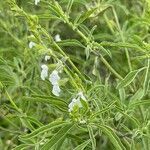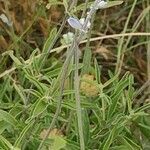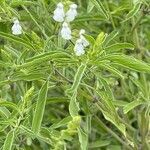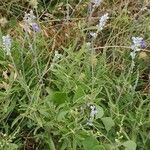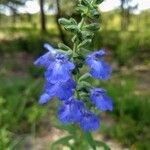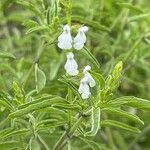Branching annual 3–6 dm, the stem with minute recurved hairs; principal petioles 8–20 mm; lvs lance-linear to lanceolate, 3–5 cm × 4–12 mm, entire or with a few low teeth, gradually narrowed to the base; racemes erect, 5–10 cm, the internodes 8–15 mm; bracteal lvs lance-linear, 1–3 mm; fls 2(4) per node; cal at anthesis 6–7 mm, minutely hairy on the nerves only, the upper lip entire, 5-nerved, half as long as the tube; cor blue, 8–12 mm, the tube no longer than the cal; 2n=20. Dry sandy or gravelly soil of hillsides and prairies; O. to Io. and Mo., w. to N.C., Utah, and Mex., and sometimes adventive eastward. (S. lanceifolia, misapplied; S. lanceolata)
Annual, erect herb, 0.50-0.75 m high; stems usually solitary, branched above; greyish tomentose, glabrescent. Leaves shortly petiolate, lanceolate to linear-lanceolate, 30-60 x 5-8 mm, base attenuate, apex obtuse, margins Sub-Entire to remotely and shallowly toothed; subglabrous above, tomentulose and gland-dotted beneath. Inflorescence lax, of several to many verticillasters, each 2-or 3-flowered. Flowers blue. Calyx deeply bilabiate, minutely hispidulous, ribbed, enlarging to 6 mm long in fruit; upper lip entire. Corolla 5-6 mm long. Flowering time Jan.-Mar.?.
Annual erect free-flowering herb 0.5-0.75 m tall; stems usually solitary, branched above, greyish tomentose, glabrescent. Leaves shortly petiolate; blade lanceolate to linear-lanceolate, 30-60 x 5-8 mm, grey-green, soft, subglabrous above, tomentulose and gland-dotted beneath, apex obtuse, base attenuate, margin subentire to remotely and shallowly toothed. Inflorescence lax, of several to many 2(-3)-flowered verticils. Calyx deeply bilabiate, minutely hispidulous, ribbed, enlarging to 6 mm long in fruit; upper lip entire. Corolla blue, 5-6 mm long.
Annual herb, 0.50-0.75 m high. Stems erect, glabrous. Leaves spreading or reflexed; blade narrowly ovate to linear-ovate, 30-60 x 5-10 mm, margins entire and irregularly serrate. Flowers: inflorescence spike-like, upper lip of calyx entire, consisting of a single, ovate tooth, ribbed, enlarging to 6 mm long in fruit; corolla up to 8 mm long, blue; Dec.-Mar.
An annual herb. It grows 60-100 cm high. It is erect and branched. The stems are square. The leaves are 5 cm long and narrowly sword shaped. The flowers are lilac or blue. They are 7-8 mm long. The fruit is a nut. It is cream to brown. It is about 2 mm long.
